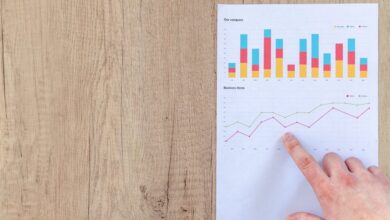Top Technical Analysis Tools for Traders: Features, Comparisons, and How to Choose the Best
Advertisement
When I first started trading, I quickly realized that gut feelings just weren’t enough. The market’s always moving, and without the right tools, it’s easy to get lost in the noise. That’s where technical analysis tools come in—they help me make sense of the charts and spot real opportunities.
I utilize these tools to analyze price trends, identify patterns, and make informed decisions. They don’t guarantee success, but they give me a clearer edge in a world full of uncertainty. Whether you’re new to trading or seeking to refine your strategy, understanding technical analysis tools can make a significant difference.
What Are Technical Analysis Tools?
Technical analysis tools enable me to study price actions, identify patterns, and forecast potential market movements. I focus on charts, indicators, overlays, and oscillators to interpret historical price data. These tools help me filter out noise and detect signals, such as trends, reversals, and support and resistance levels.
I use chart types like candlestick, bar, and line charts to visualize time-based price movements. Technical indicators, such as RSI, MACD, and moving averages, help quantify market strength and direction. Volume-based tools such as On-Balance Volume add another dimension for confirming momentum or divergences.
Trendlines, Fibonacci retracements, and Bollinger Bands help define key areas and volatility. Oscillators like Stochastic provide overbought or oversold signals. By combining multiple analysis tools, I align price action with volume and volatility measures, which strengthens my decision-making framework.
Technical analysis tools offer a data-driven approach to navigate ever-changing market conditions, complementing other methods of trade evaluation.
Key Features to Look For in Technical Analysis Tools

- Chart Variety and Customization Options
Chart variety and customization options expand my ability to analyze market trends. Platforms with candlestick, bar, and line chart types, along with adjustable timeframes, allow me to tailor my view to any market situation.
- Comprehensive Indicator Library
Comprehensive indicator libraries include moving averages, RSI, MACD, Bollinger Bands, and Fibonacci retracements. I compare multiple market conditions using them, which broadens my analysis and supports deeper forecasting.
- Real-Time Data and Speed
Real-time data and speed ensure my trading insights are immediate. Delayed information often distorts patterns, but instant prices and indicator updates keep me aligned with current market momentum.
- Backtesting Capabilities
Backtesting capabilities help me validate and refine my trading strategies. When I test indicators and setups against historical data, I evaluate effectiveness based on past market conditions.
- User-Friendly Interface
User-friendly interfaces reduce time spent navigating complex tools. Dashboards with intuitive layouts and clear control options help me focus on actionable information.
- Integration With Brokerage Accounts
Integration with brokerage accounts connects my technical analysis directly to order execution. Platforms that sync with brokers allow me to move seamlessly from analysis to trade without switching services.
- Alert and Notification Systems
Alert and notification systems keep me updated on critical price levels and indicator signals. Customizable alerts across devices ensure I never miss key setups.
- Mobile and Cross-Device Compatibility
Mobile and cross-device compatibility give me the flexibility to analyze and trade from any device. Synchronization between my desktop and mobile devices maintains workflow continuity, wherever I am.
| Feature | Example Tools | Purpose |
|---|---|---|
| Chart Types & Customization | TradingView, MetaTrader 5 | Custom analysis of trends and timeframes |
| Indicator Library | ThinkOrSwim, NinjaTrader | Access to broad technical indicators |
| Real-Time Data | Bloomberg Terminal, eToro | Immediate, accurate price and volume information |
| Backtesting | MetaTrader, Amibroker | Historic testing and validation of trading ideas |
| Brokerage Integration | Interactive Brokers (IBKR), E*TRADE | Direct trade execution from the analysis platform |
| Alerts/Notifications | TradingView, StockCharts | Timely notification of events and signals |
| Cross-Device Compatibility | Webull, Robinhood | Trading and analysis on mobile and desktop |
Including these features in my tools enables me to adapt to changing markets, streamline my workflow, and make more informed data-driven decisions.
Popular Types of Technical Analysis Tools
Popular types of technical analysis tools support my trading decisions with actionable insights and precise data visualization, providing valuable guidance. Each tool type offers unique features that enhance different aspects of market analysis.
Charting Platforms
Charting platforms provide me with real-time price movements and advanced visualizations for multiple assets. Platforms like TradingView, MetaTrader, and Thinkorswim include hundreds of technical indicators, one-click drawing tools, multi-timeframe support, and customizable chart layouts. I monitor candlestick, line, and bar charts to compare patterns across different timeframes, identify support and resistance levels, and spot trend reversals or breakouts.
Indicators and Oscillators
Indicators and oscillators measure price strength, momentum, and trend direction to supplement my analysis. I use indicators including Moving Average Convergence Divergence (MACD), Relative Strength Index (RSI), and simple moving averages (SMAs) to highlight shifts in trend or momentum. Oscillators such as the Stochastic, Commodity Channel Index (CCI), and Williams %R help determine overbought or oversold market conditions. By interpreting these values, I decide when to enter or exit trades based on statistical signals rather than emotions.
Pattern Recognition Software
Pattern recognition software automates the detection of technical price patterns, helping me consistently capture opportunities. Tools such as Autochartist, PatternSmart, and Trading Central automatically recognize chart formations, including head-and-shoulders patterns, triangles, flags, and double tops. These tools also provide alerts and probability metrics, supporting my strategy by reducing manual chart scanning and quickly highlighting high-probability setups.
Comparing Top Technical Analysis Tools
Comparing top technical analysis tools provides me with a clearer view of which platforms best align with my trading goals and workflow. I focus on key factors such as analytical depth, ease of use, and cost when assessing these solutions.
Strengths and Weaknesses
- TradingView: TradingView offers an intuitive interface, advanced charting, and an extensive indicator library, allowing me to customize nearly every aspect of my analysis. Collaboration features and community scripts add value, though limited broker integration and premium pricing constrain some users.
- MetaTrader (MT4/MT5): MetaTrader delivers robust backtesting, algorithm support, and custom indicator development, which suits my automated strategy needs. The interface appears dated, and access to live data or broad asset classes outside Forex feels restricted.
- Thinkorswim: Thinkorswim by TD Ameritrade presents advanced analytics, real-time data, and seamless broker integration, supporting equities and options trading with precision. The high learning curve and US-only account access limit its appeal for global traders.
- Pattern Recognition Platforms: Tools like Autochartist and MetaStock automate pattern identification, reducing my manual screening time. Occasionally, signal quality varies, and over-reliance on automated suggestions might lead to missed contexts or opportunities.
Pricing and Accessibility
| Tool | Pricing (As of Q2 2024) | Accessibility |
|---|---|---|
| TradingView | Free / $14.95-59.95/month (Pro+) | Web, iOS, Android |
| MetaTrader | Free with most brokers | Windows, Mac, Mobile |
| Thinkorswim | Free (TD Ameritrade clients only) | Windows, Mac, Web |
| Autochartist | Broker-dependent (often a free add-on) | Broker Platform, Web |
| MetaStock | $69-149/month or $499-1,395 one-time | Windows |
TradingView lets me start free with core features and scale up for premium diagnostics. MetaTrader remains widely accessible due to integration with countless brokers. Thinkorswim is free for TD Ameritrade clients, but it excludes non-US residents. Pattern recognition tools, such as Autochartist, may be included with broker accounts, while MetaStock positions itself at the premium end for comprehensive analytics, potentially limiting entry for some retail traders.
When I weigh features, platform strengths, and cost structure, the utility of each tool depends on my requirements for automation, visual power, asset coverage, and compatibility with my trading workflow.
Choosing the Right Tool for Your Trading Style
Analyzing how technical analysis tools align with my trading approach enables me to make better decisions. I weigh the unique demands of my trading frequency, asset preferences, and risk management techniques when selecting software.
- Day Trading Needs
Fast-paced environments favor charting platforms that provide real-time updates and execute quickly. I pick tools like Thinkorswim or TradingView when I need rapid price feeds, customizable hotkeys, and reliable chart overlays. Quick alerts and seamless order routing support my intraday strategies.
- Swing Trading Preferences
Broader timeframes require platforms with multi-chart layouts, comprehensive backtesting, and deep indicator libraries. I choose MetaTrader and TradingView to combine various oscillators and moving averages, and compare historical setups across daily charts. Custom scripting lets me automate pattern discovery in multi-day moves.
- Long-Term Investing Requirements
Holding positions for weeks or months requires robust portfolio analysis, fundamental overlay integration, and clear macro trend visualizations. Charting suites with extensive data histories, such as MetaStock or TradingView, track sector rotations and cross-asset correlations. Pattern recognition tools help validate entry and exit signals on weekly or monthly charts, providing a more accurate assessment of market trends.
- Automated Strategy Implementation
Algorithmic trading strategies leverage platforms with scripting and backtesting power. I rely on MetaTrader’s MQL and TradingView’s Pine Script environments to code, optimize, and deploy systematic approaches. Reliable API access and integration with brokerage houses streamline execution and risk controls.
- Mobile and Cross-Device Flexibility
Active lifestyles and remote monitoring benefit from platforms that offer synchronized experiences across desktop, tablet, and phone. TradingView’s mobile app and Thinkorswim’s companion tools enable me to track trades and receive market alerts wherever I am.
Mapping tool features to my unique trading cadence and objectives support consistency, accuracy, and adaptability. By focusing on interface efficiency, analytical capabilities, and integration quality, I maintain alignment between my technical approach and execution.
Conclusion
As I continue to refine my trading strategies, I’ve found that choosing the right technical analysis tools makes all the difference. Staying adaptable and data-driven enables me to respond confidently to market shifts instead of reacting impulsively.
With numerous tools available, it’s worthwhile to take the time to explore which features truly support your workflow and trading goals. The right combination can empower you to spot opportunities and manage risk more effectively, helping you trade with greater clarity and confidence every day.
Frequently Asked Questions
What are technical analysis tools in trading?
Technical analysis tools are instruments and software used to examine price trends, patterns, and market behavior. They help traders analyze charts, indicators, and volume to make informed trading decisions, rather than relying on gut feelings.
Why are technical analysis tools important for traders?
These tools give traders a structured, data-driven approach to understanding market trends. While they don’t guarantee success, they provide valuable insights, increase confidence, and reduce emotional decision-making by highlighting actionable opportunities and risks.
What are the most common technical analysis tools?
Popular tools include charting platforms (such as TradingView, MetaTrader, and Thinkorswim), indicators like RSI and MACD, oscillators, volume-based tools like On-Balance Volume, and pattern recognition software that automatically identifies trade setups.
How do I select the most suitable technical analysis tool for my trading style?
Consider factors such as your trading frequency (day, swing, or long-term), preferred assets, need for real-time data, backtesting features, user interface, broker integration, alerts, and whether you need mobile access or automation capabilities.
Can technical analysis tools guarantee profits?
No, technical analysis tools do not guarantee profits. They provide a statistical edge by highlighting trends and patterns, but must be used in conjunction with sound risk management and trading discipline to enhance overall performance.
What are the key features to look for in technical analysis platforms?
Look for chart variety, customizable indicators, real-time data, backtesting capabilities, a user-friendly design, broker integration, alert systems, and seamless mobile and device compatibility to support efficient and adaptable trading.
Which platforms are best for day trading and swing trading?
Thinkorswim and TradingView are ideal for day trading due to their real-time updates and fast execution, while MetaTrader and TradingView are suitable for swing trading with their multi-chart layouts and robust backtesting capabilities.
Is technical analysis only for professional traders?
No, both beginners and experienced traders can benefit from technical analysis tools. Many platforms offer educational resources, intuitive interfaces, and customizable features suitable for different skill levels.
Do you know if I can automate my trading strategies with these tools?
Yes, several platforms, such as MetaTrader and TradingView, support scripting and automation, allowing traders to backtest and implement automated strategies for efficient and consistent trading.
Do technical analysis tools work on mobile devices?
Many modern platforms, such as TradingView and Thinkorswim, offer mobile apps and cross-device compatibility, allowing users to access their accounts from multiple devices. This will enable traders to monitor markets, manage alerts, and execute trades on the go.










